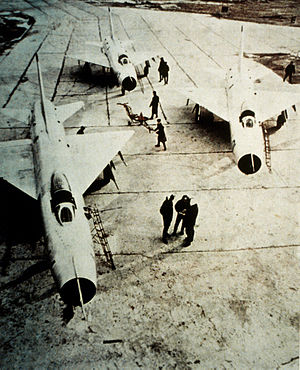
Plan for the development of Polish military aviation in 1970-1985.
The MiG-21 was the most massive jet combat aircraft in the Polish military aviation. In the photo, the MiG-21MF takes off from the roadway of the airport. Photo by Robert Rohovich
The seventies of the last century were a period in the history of the Polish People's Republic, when, thanks to the intensive expansion of many sectors of the economy, the country had to catch up with the West in terms of modernity and way of life. At that time, the plans for the development of the Polish Army were focused on improving the organizational structure, as well as weapons and military equipment. In the upcoming modernization programs, opportunities were sought for the widest possible participation of Polish technical thought and production potential.
It is not easy to describe the state of aviation of the Armed Forces of the Polish People's Republic at the end of the XNUMXs, since it did not have a single organizational structure, not a single decision-making center.
In 1962, on the basis of the Headquarters of the Air Force and Air Defense of the National District, the Aviation Inspectorate and two separate command cells were created: the Operational Aviation Command in Poznań and the National Air Defense Command in Warsaw. The operational aviation command was responsible for frontline aviation, which during the war was transformed into the 3rd Air Army of the Polish Front (Coastal Front). At its disposal were units of fighter, assault, bomber, reconnaissance, transport and increasingly advanced helicopter aviation.
The National Air Defense Forces, in turn, were given responsibility for the air defense of the country. In addition to fighter aviation regiments, they included regiments and battalions of radio engineering troops, as well as divisions, brigades and regiments of missile troops and artillery of the defense industry. At that time, the greatest emphasis was placed on the creation of new anti-aircraft missile squadrons.
Finally, the third piece of the puzzle was the Aviation Inspectorate in Warsaw, which was responsible for conceptual work on the use of aviation, education, and technical and logistical facilities.
Unfortunately, a unified control system for these highly developed forces and means has not been created. Under these conditions, each of the commanders took care of his own interests first of all, and any disputes about competence had to be resolved at the level of the Minister of National Defense.
In 1967, this system was improved by merging the Aviation Inspectorate and the Operational Aviation Command into one body - the Air Force Command in Poznań, which began its work at the beginning of the next year. This restructuring was supposed to put an end to disputes, including on issues of equipment at the level of the Armed Forces of the Polish People's Republic, in which the new command was to play a decisive role.
The signal for a new approach was prepared in March 1969 "A Framework Plan for the Development of Aviation for 1971-75 with a view to 1976, 1980 and 1985." It was created in the Air Force Command, and its scope covered the organizational and technical issues of all types of aviation of the Armed Forces of the Polish People's Republic.
Starting point, structures and equipment
The preparation of each development plan should be preceded by a deep analysis of all factors that may affect certain provisions in the document being created.
At the same time, the main factors took into account the state of forces and plans of a potential enemy, the financial capabilities of the state, the production capacity of its own industry, as well as the currently available forces and means that will be subject to changes and the necessary development.
Let's start with the last one, i.e. belonging to the Air Force, the Air Defense Forces of the country and the Navy in 1969-70, since the plan had to be implemented from the first days of 1971. The period of 20 months between the creation of the document and the beginning of the implementation of the adopted provisions was clearly planned, both in terms of organization and in terms of purchasing equipment.
At the beginning of 1970, the Air Force was divided into an operational direction, i.e. 3rd Air Army, formed during the war, and auxiliary forces, i.e. predominantly educational.

